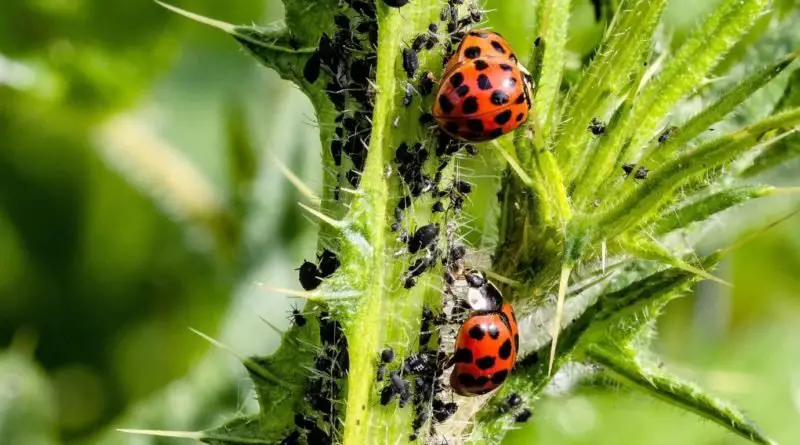Last modified on October 22nd, 2020 at 9:01 pm
Eco-Friendly Alternative Pest Control Methods for Your Farm and Garden
Household pests are more than an annoyance, they can carry serious diseases and cause major damage to your possessions and property.
When it comes to your garden, pests can quickly undo all your hard work and they pose a significant financial risk for farmers. So it makes sense to get rid of them as soon as you realize they’ve made themselves at home in your environment.
The trouble is, traditional pesticides also pose a significant risk to human and animal health. According to the World Health Organization, at least 300,000 people die from pesticide-related poisoning every year.
So, if you want to avoid accidental poisonings, and you care about the environment, it’s time to embrace alternative pest control on the farm and garden environment.
What Is Alternative Pest Control?
Most alternative pest control methods are organic in nature. They aim to cause the least environmental damage and harm to non-targeted species.
These methods aim to use the least toxic method first when combating pests.
Unfortunately, nothing kills pests quicker than commercial pesticides. So, if you want to get rid of pests safely using alternative methods, you’ll need a multi-pronged approach.
There’s no quick fix when it comes to pest control using these methods. Fortunately, you don’t have to adopt these time-consuming approaches on your own anymore.
Nowadays the best exterminators embrace these holistic pest control practices to keep your home and business free of unwanted visitors.
The Most Effective Pest Control Alternatives
As the first defense against pests, you should do everything you can to help your plants resist pest infestations.
Give your plants a fighting chance by making life easy for them. Healthy plants are less likely to succumb to the ravages of pest infestations.
So, remove any weak specimens, and keep your beds and fields free of weeds. Crop rotation also helps prevent pest populations from taking hold, since most insects have a preferred host species.
Create healthy soil using natural composting methods, top dressing, and mulching.
Practice no-till digging to minimize disturbances and limit the introduction of pests to the soil. No-till digging also helps beneficial microbes in the soil thrive.
The next step is identifying the problem pest so you can adopt a suitable means of eradicating them.
Unfortunately, nothing kills pests quicker than commercial pesticides. So, if you want to get rid of pests safely, you’ll need a multi-pronged approach. The CDC recommends these integrated pest management principles to control pests safely.
Physical Barriers
Barriers make it impossible for pests to reach your plants by physically blocking them. Some of the most effective methods are mulch, hotkaps, and pest nets.
IRT mulch consists of a plastic sheet that you place over the soil to suppress weeds and reduce pest habitats. It won’t save your plants’ leaves from hungry flying predators though. This covering generates heat during the daytime which discourages slugs and snails from making themselves at home underneath it or crossing over it to reach your plants’ leaves.
Netting placed over plants in a tent-like fashion will deter insects and birds from snacking on your plants.
Hotkaps are a type of waxy paper cap that you can use to cover your plants and seeds. As the plants grow, you can open the tops to encourage growth while still protecting the tender lower shoots.
This cover prevents birds from nibbling on seedlings and can discourage cucumber beetles until the plants are big enough to resist them.
There are a few downsides to barrier methods. They can also trap insects inside, so check regularly for pests, like flea beetles, that rise from the soil.
If you use hay or straw to mulch your plants, you could unwittingly provide slugs with a favorable hiding place.
An Ancient Remedy
Diachomatious earth is a type of sedimentary rock made from compressed fossilized diatoms, which are hard-shelled algae. It’s a dust-like material that kills pests by absorbing lipids from their exoskeletons when they crawl over it.
D.E. isn’t toxic to mammals but it is abrasive, so always wear gloves and goggles when handling it.
Plant-Based Alternative Pest Control Methods
Several plants repel different types of insects. Planting these species around your crops will send insects scuttling.
There’s a plant that can help you deter almost any kind of bug, but these are some of the more commonly used, and most effective ones:
- Herbs like basil, coriander, parsley, and borage repel worms and beetles
- Chamomile’s repulsive to flying insects
- Ants, aphids, and Japanese beetles dislike catnip
- Artemesia repels lopers, maggots, and cabbage butterflies
- Geraniums deter leafhoppers
- Nasturtiums work for squash bugs
Almost any strong-smelling plant’s bound to have some insect-repelling properties including all the members of the onion family like leeks, garlic, and chives.
Predator Power
In nature, almost everything has something else that eats it. Insects are no exception. When you grow plants that attract these enemies of common garden pests, you’ll greatly reduce their numbers.
Create a predator habitat of perennial plants near your crops to help keep insects away. You won’t need to replant it every year, and your garden watchdogs will happily defend your crops all day and night long.
Spiders and wasps are fantastic predators, so don’t disturb their nests and webs. They’ll take care of many insect species that can harm your plants but they won’t cause any damage themselves.
Other defenders of the vegetable garden include praying mantises, ladybugs, and robber flies.
Pest Picking Alternatives to Pest Control
Removing pests when you see them can prevent insect infestations from taking hold. Simply pick them off or blast them with a spray bottle or garden hose.
The best time to pick on pests is during the coolest part of the day when they’re sluggish. Bring a cup of hot water filled with dishwashing liquid along for the occasion and drop your pickings in the glass.
Another way to capture insects is by placing newspaper under a heavily infested plant and shaking it until the bugs fall onto the newspaper. Afterward, you can funnel the insects into your soapy prison.
Organic Pesticides
Organic pesticides attempt to fill in where traditional insecticides fall short. They use biological means to control and kill pests and are usually target-specific.
Some organic pesticides can harm plants and beneficial insects, so always read the package instructions carefully before you use them.
Microbial Insecticides
These types of insecticides are very specific to the target pest and totally harmless to beneficial insects and animals. They’re basically illnesses specific to particular types of insects.
One of the most widely used microbial pesticides is Bt. It’s a type of bacteria that kills various species of worm larvae by paralyzing their digestive systems.
Insecticidal Soaps
These soaps contain salts and fatty acids that penetrate the soft outer shell of certain insects and damage their cell membranes.
They’re effective against mealybugs, earwigs, thrips, and early-stage scale. Insecticidal soaps aren’t safe for use on all plants and can also harm beneficial insects, so use them sparingly.
They’re totally harmless to humans and other mammals. You can use a few drops of dishwashing liquid dissolved in water as a type of insecticidal soap.
Insecticidal Oils
Insecticidal oils comprise a petroleum-based, horticultural grade liquid that coats the insects and cuts off their oxygen supply.
It’s most effective against immature insects, larvae, and eggs. You can use insecticidal oils to control aphids, spider mites, psylla, scale, and mealybugs. Be careful though and always read the package instructions, these oils can also affect beneficial insects and some plants.
Neem Oil
Neem oil works as a repellent and poison and deters insects from feeding on plants. It can also sterilize some insect species and slow or stop the growth of others.
You can use neem oil as a soil drench or foliar spray against aphids, loopers, mealybugs, and loopers.
Plants absorb the neem extracts into their foliage, and it remains in the plant tissue, so it can also repel leaf minors that are impervious to the usual foliar sprays.
It can also harm beneficial insects so make sure you only spray plants affected by the specific insect you’re targeting. It’s largely non-toxic to animals although it can make them ill if ingested.
Use Pyrethrin With Caution
Pyrethrin is a type of botanical insecticide derived from the Pyrethrum daisy. It’s a contact insecticide and is largely non-selective, so it kills all sucking and chewing insects.
Pyrethrin isn’t as harmful as Pyrethroid which is toxic to all insects, but it can kill ladybugs, bees, and fish. It’s also mildly toxic to mammals.
Rather leave the use of this insecticide to the experts.
Move With the Times
One of the great joys of living in modern times is that we keep finding better ways to do things. Alternative pest control methods are just one of the ways to incorporate green principles into your life.
There’s always a better way to achieve your aims without causing unnecessary harm. Browse our blog for more wonderful ideas on eco-friendly lifestyle choices.




